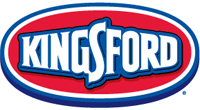Kingsford (charcoal)
 The Kingsford logo | |
| Product type | Charcoal |
|---|---|
| Owner | The Clorox Company |
| Country | United States |
| Introduced | 1920 |
| Markets | Worldwide |
| Previous owners | Ford Charcoal |
| Tagline | "Start Something" |
| Website | www |
Kingsford is a brand that makes charcoal briquettes, along with related products, used for grilling. Established in 1920, the brand is owned by The Clorox Company. Currently, the Kingsford Products Company remains the leading manufacturer of charcoal in the United States, with 80% market share. More than 1 million tons of wood scraps are converted into charcoal briquettes annually.[1]
History
[edit]Ford Motor Company sold more than one million Ford Model Ts in 1919. Each one used 100 board feet of wood for parts such as the frame, dashboard, steering wheel, and wheels. Because of the amount of wood needed, Henry Ford decided to produce his own supply. He enlisted the help of Edward G. Kingsford, a real estate agent and timber cruiser from Michigan, to locate a supply of wood. Kingsford’s wife was a cousin of Ford.[2] In the early 1920s, Ford acquired large timberland in Iron Mountain, Michigan, and built a sawmill and parts plant in a neighboring area which subsequently became Kingsford, Michigan. The mill and plants produced sufficient parts for the cars, but generated waste such as stumps, branches and sawdust. Ford suggested that all wood scraps be processed into charcoal.[3]
A University of Oregon chemist, Orin Stafford, invented a method for making pillow-shaped lumps of fuel from sawdust and mill waste combined with tar and bound together with cornstarch. He called the lumps "charcoal briquettes."[4] Thomas Edison designed the briquette factory adjacent to the sawmill and Kingsford ran it. Ford named the new business Ford Charcoal. It was a model of efficiency, producing 610 lb (280 kg) of briquettes for every ton of scrap wood. In the beginning, Ford's "briquettes" were sold only through Ford dealerships. The charcoal was marketed to meat and fish smokehouses, but demand soon exceeded supply.[5]
By the mid-1930s, Ford was marketing "Picnic Kits" containing charcoal and portable grills, capitalizing on the link between motoring and outdoor adventure that his vagabond travels popularized. "Enjoy a modern picnic," the packages read, "Sizzling broiled meats, steaming coffee, toasted sandwiches." But it wasn’t until after World War II that backyard barbecuing took off, thanks to suburban migration, the invention of the Weber grill, and increased marketing efforts. In 1951 an investment group bought Ford Charcoal and took over operations, renaming it Kingsford Charcoal in honor of Edward G. Kingsford and Kingsford, Michigan. The company was later acquired by Clorox in 1973.[6]
Manufacturing
[edit]
Kingsford charcoal is made by charring hardwoods such as oak, maple, hickory, walnut, etc. (Depending on which regional manufacturing plant it comes from.) That char is then mixed with other ingredients to make a charcoal briquette. As of January 2016, Kingsford Charcoal contains the following ingredients:[7][8]
- Wood char - Fuel for heating
- Mineral char - Fuel for heating
- Mineral carbon - Fuel for heating
- Limestone - Uniform visual ashing
- Starch - Binding agent
- Borax - Release from press molds
- Sawdust - Accelerate ignition
The raw materials, primarily wood scraps from regional sawmills, are delivered to Kingsford factories. The material undergoes magnetic filtration to remove any foreign metal objects. The wood scraps are milled into smaller wood chips. The material then moves into an industrial dryer filled with hot air to remove any moisture.[9] The wood chips are later processed through a large furnace with multiple hearths (called a retort) in an oxygen controlled atmosphere that chars the wood without it burning. The wood gets progressively more charred as it drops from one hearth to the next. The charred wood chips are combined with the other dry ingredients and go through a hammermill which breaks everything down into small particles. This moves to a mixer where it is combined with the wet ingredients, starch and borax. This mixture is press formed into pillow-shaped briquettes and move on to be dried before being packaged for sale.[10]
Kingsford also retails products that combine their charcoal with other flavors and spices to create flavored smoke.[11]
Plant locations
[edit]Charcoal facilities
[edit]Retort facilities
[edit]References
[edit]- ^ Kingsford : : Our Heritage
- ^ "Henry Ford's Connection to Charcoal". Knowledge Stew. September 26, 2014. Retrieved December 7, 2016.
- ^ "Henry Ford, the Vagabonds, E.G. Kingsford, and the History of the Charcoal Briquette". UNREMEMBERED. June 21, 2016. Retrieved February 26, 2023.
- ^ US patent 1609097A, Stafford, Orin F., "Process of making charcoal briquettes and product derived therefrom", published 1926-11-30
- ^ Slater, Dashka (September 26, 2014). "Who Made that Charcoal Briquette?". The New York Times Magazine. Retrieved December 7, 2016.
- ^ "Clorox Sets Kingsford Deal". The New York Times. December 1, 1972. p. 54. Retrieved February 26, 2023.
- ^ "All About Charcoal". The Virtual Weber Bullet. Retrieved February 26, 2023.
- ^ "Home Depot Safety Data Sheet" (PDF).
- ^ "Oregon's Kingsford plant is king". Billings Gazette. June 30, 2001. Retrieved December 7, 2016.
- ^ "Kingsford Brand Charcoal ingredients". California BBQ Association. August 2000. Archived from the original on January 2, 2018. Retrieved December 7, 2016.
- ^ "Kingsford Launches Flavored Charcoal and Wood Pellet Line, Signature Flavors". CookOut News. March 22, 2022. Retrieved March 22, 2022.
